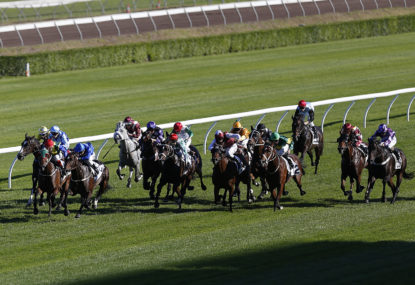TWO GOOD! Zahra wins back-to-back Melbourne Cups on Without a Fight as three horses pull up lame
Without a Fight completed the rare Caulfield Cup-Melbourne Cup double on Tuesday as star jockey Mark Zahra went back-to-back in the big one after…

Australia may not be considered one of the world’s premier racing nation, but one area in which this country leads the world internationally is the finite art of racecalling.
Australia has a heady racecalling tradition, stretching back to legendary wordsmiths like ‘the accurate one’ Bill Collins, Bert Bryant, Des Hoysted, Ken Howard and John Tapp.
So why is it that Australia’s racecallers are so highly sought after on the world stage? A couple of events in the world of racing this week had me thinking about this very question.
The first was the announcement that one of Australian racing’s rising stars, Anthony Manton, is returning home after a two-year stint in Kuala Lumpur.
He cited the uncertain future of Malaysian racing as the reason for his return.
“The club has been great to me and I’ve really enjoyed my time here, but unfortunately racing in Malaysia is currently going through a very tough period,” he said in a press release issued this week.
“Since the tote pulled out of racing earlier this year, there have been significant prizemoney cuts and cancelled race meetings and racing is currently in a rebuilding phase.
“There are other opportunities for me to pursue and the club and I have agreed to a release.”
Malaysian racing has been in turmoil for a number of years. The aim of riding the coattails of other hugely successful Asian racing jurisdictions like Hong Kong, Japan and Singapore has proven fanciful, with widespread corruption plaguing the industry.
Stories out of Malaysia are uncomfortable to hear and deserve thorough analysis beyond my limited timeframe. It is something I hope to investigate in the coming months.
As for Manton, highly rated among his peers and vastly improved for his experience in Kuala Lumpur, he will continue return to Malaysia to call feature races for the time being.
In time, though, it wouldn’t surprise to see him venture to another jurisdiction worldwide, joining a vast number of Australian racecallers across the world.
Head across the Tasman, you’ll find former Sydney harness caller Mark McNamara calling all three codes in Christchurch.
In Asia, you’ll find Darren Flindell and Brett Davis in Hong Kong, Craig Evans and Matt Jones in Singapore, Murray Johnson in Japan and Harry Troy in Macau.
For the three months of the year that racing occurs in Dubai, Terry Spargo is behind the binoculars.
The doyen of English racecallers is Jim McGrath, an expat Australian who was the BBC’s senior commentator from 1997 to 2012, while Sky Racing’s Arthur Cooper provides English commentary from France.
In the United States, you’ll find Rob Geller at Emerald Downs and Sunland Park, Peter Berry at Mountaineer Park and Michael Wrona at Golden Gate Fields.
It seems the Australian diaspora has been to the benefit of other jurisdictions.
Michael Cox, a journalist for Hong Kong’s South China Morning Post, believes the success of Australian commentators is due to their experience in other sports.
“Perhaps it is the frantic nature of their football codes, particularly the unpredictable Australian Rules, that gives Aussies an edge in the race-calling stakes and explains the proliferation of antipodean expats in on-course broadcasting booths throughout Asia and the world,” he wrote after last year’s Hong Kong International Races.
I think he has a point, as the styles of each country’s racecallers tends to reflect their experiences in other sports.
Take the Americans.
They seem to oscillate between a slow, almost boring, recital of the runners in order, and an exaggerated excitement as they are in the stretch.
It’s very much a style that is reflected in American football, for example, where exciting plays are separated by drawn-out moments.
Listening to last weekend’s Kentucky Derby, NBC commentator Larry Collmus was the embodiment of excitement as they left the gates, began his recital as they came past the famous twin spires the first time, before ramping it up again at the quarter mile.
All you needed to hear was Collmus calling “Orrrrrrrrrrrrrrrrrrrrrrrrrrrrrrrrrb” at the top of the stretch to understand the American style of calling.
It’s not a slight against Collmus, though. It’s a style that has been employed by the likes of Chic Anderson and Tom Durkin before him.
Another reason for the prevalence of Australian callers is the fact the Aussie twang is the closest thing to a neutral English-speaking accent. A refined Australian accent can easily be mistaken for a number of other accents and is easy on the ear.
Of course, I say this without a slight hint of bias at all.
Perhaps others may have their own beliefs as to why Australian racecallers are successful overseas. I’d love your thoughts.